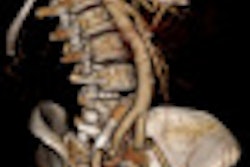A study presented at the American Roentgen Ray Society (ARRS) meeting found that patients who are more likely to suffer from renal insufficiency are more likely to be at risk to develop contrast-induced nephrotoxicity (CIN).
Prior to these findings, patients with a history of diabetes were considered to be at greatest risk. However, a study of more than 2,400 patients having contrast-enhanced CT exams showed that patients with a history of heart disease, hypertension, and/or renal disease revealed that these patients were at greater risk than diabetic patients.
Dr. Vahid Yaghmai, associate professor of radiology at Northwestern University, told attendees that being male and having a history of renal disease, hypertension, and/or heard disease were the most important predictors for having renal insufficiency.
The retrospective study analyzed the outcomes of patients who underwent an estimated glomerular filtration rate (eGFR) test immediately before undergoing a CT exam.
Of the 2,404 patients, 27% had eGFR scores of fewer than 60. The odds ratio for CIN for patients with renal disease was 3.95, followed by hypertension at 2.39, and heart disease at 1.46. By comparison, the odds ratio for patients with diabetes mellitus was much lower at 1.16.
Yaghmai noted that some radiologists ask patients to complete a survey to determine if patients are at risk for CIN. Based on the survey results, patients most at risk undergo a test to measure their renal function. Performing an eGFR test immediately before performing a contrast-enhanced CT scan may better help radiologists accurately determine at-risk patients, Yaghmai concluded.



















